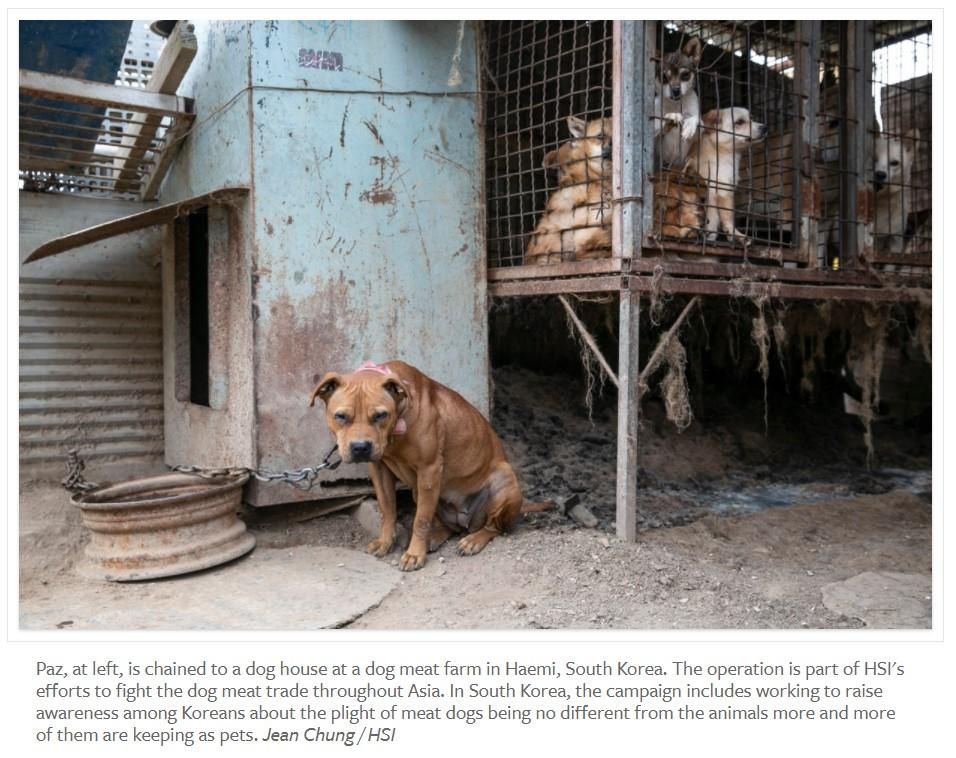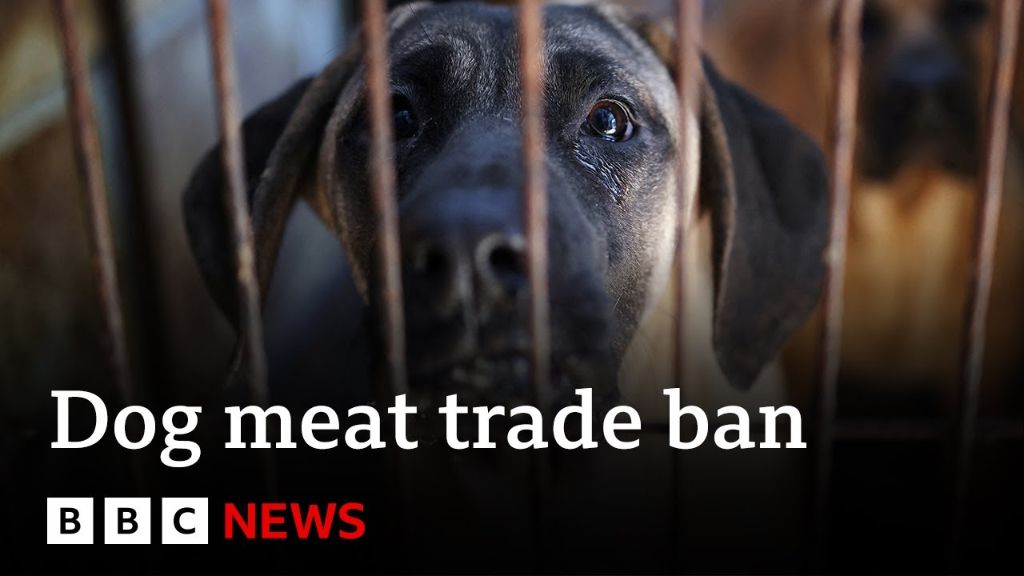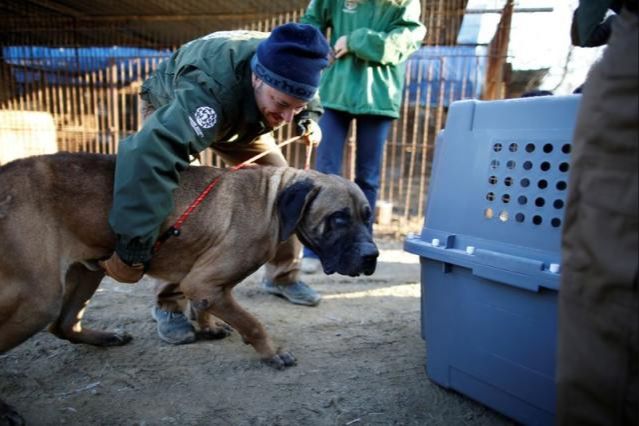The scope of the dog meat trade
Although reliable data on the dog meat trade is scarce, various welfare groups estimate that at least 1 million dogs are killed every year to be eaten. [1]
The dog meat trade is most prevalent in parts of Asia, including China, South Korea, Vietnam, and Indonesia. An estimated 10-20 million dogs are slaughtered annually in China alone, up to 1 million in South Korea, 1 million in Indonesia, and around 5 million in Vietnam. [2]
The high demand for dog meat in these countries drives the trade. Many consume dog meat for its purported health benefits and as part of certain cultural traditions. The trade persists because of economic factors – dog meat can be a lucrative business and cheap source of protein.
Animal welfare concerns

The dog meat trade involves extremely inhumane treatment of animals. Dogs are often crammed into tiny cages on trucks and transported long distances to slaughterhouses without food or water. According to the Humane Society International (HSI), many dogs die during transport from sickness, injuries or dehydration [1].
Slaughter methods are often unregulated and incredibly cruel. Common methods include electrocution, hanging, beating and boiling dogs alive [1]. These methods inflict extreme fear, pain and suffering.
The unhygienic conditions also increase risks of diseases like rabies. HSI reports that the dog meat trade spreads rabies and increases human health risks, as dogs are not vaccinated or inspected [1].
Furthermore, the trade is linked to criminal activities like dog theft. Dogs are often stolen pets or strays rounded up off the streets, violating animal protection laws [2].
Cultural and historical context
The practice of eating dog meat has ancient origins, dating back thousands of years in some parts of the world. According to Wikipedia, the consumption of dog meat in China can be traced back to around 500 BCE, and possibly even earlier. In other regions like North America, some Native American tribes were eating dogs as early as 8,000–10,000 years ago based on archaeological evidence, as noted by National Geographic.
In certain cultures, dog meat has been considered a traditional delicacy and is sometimes consumed for supposed health benefits. Historically, dogs were also eaten out of necessity in times of famine or food scarcity in some areas. While the practice has declined in modern times, there are still regions, especially in parts of Asia, where dog meat is culturally significant and regularly consumed.
Health risks
The unregulated dog meat trade poses serious health risks, especially from the spread of disease that can transmit from dogs to humans. According to a study published in BMC Public Health, the trade fueled by dog meat consumption is a major risk factor for rabies exposure in some environments (https://www.ncbi.nlm.nih.gov/pmc/articles/PMC4056491/). Rabies poses a significant public health threat and is almost always fatal once clinical signs appear. The trade has also been linked to outbreaks of other zoonotic diseases like trichinellosis, cholera and chlamydia (https://www.hsi.org/news-resources/dog-meat-trade-faqs/).
The lack of regulation and oversight in the dog meat trade means animals are often slaughtered and processed under poor hygiene conditions. Dogs are typically caught and confined in crowded, unsanitary conditions where disease can quickly spread. Slaughtering and butchering without protective equipment or safety standards further increases risks. Consuming dog meat from unknown sources is extremely risky compared to legal, regulated meat industries. The trade jeopardizes human health unless significant reforms are made to enforce safety standards. However, ending the trade entirely would be the most effective way to eliminate these public health threats.
Arguments for ending the trade
There are several compelling arguments for ending the dog meat trade. First and foremost is the extreme animal cruelty involved. Dogs raised for meat farming suffer in small, filthy cages and are often killed via brutal methods like bludgeoning, hanging, or electrocution. This causes immense and unnecessary suffering. Ending the trade would eliminate this cruelty.
The dog meat trade also poses major health risks. Dogs are often fed waste food, spreading disease. Slaughtering and butchering dogs lacks regulation, leading to unsanitary conditions. Consuming dog meat has been linked to cholera, rabies, and trichinosis. Banning the trade would improve public health.
Additionally, younger generations in many Asian countries are strongly rejecting the dog meat trade and pushing for its end. They see dogs as pets, not food. As views evolve, continuing the trade makes less cultural sense. Phasing it out aligns with changing social norms.
Education and awareness campaigns

Animal welfare groups like Humane Society International (HSI) have launched extensive campaigns to educate the public about the cruelty involved in the dog meat trade. According to HSI’s website, “Our campaigns aim to raise awareness of the animal welfare issues, food safety risks and potential spread of disease associated with the dog meat trade in Asia” (https://www.hsi.org/news-resources/stop-dog-meat-trade/). These efforts are focused on changing attitudes and convincing consumers to stop eating dog meat.
For example, HSI’s Asia Dog Meat campaign includes street campaigns, media engagement, celebrity involvement, and partnerships with local animal protection groups. According to an HSI blog post, they have worked to educate consumers that “dogs are companion animals, not food” and spotlighted the health risks of consuming dog meat (https://www.humanesociety.org/blog/2023-fight-end-dog-cat-meat-trade). These initiatives have helped shift cultural perceptions and decrease demand for dog meat.
Meanwhile, the StopTheTorture initiative led by Lisa Vanderpump seeks to spread awareness through social media engagement and partnerships. Their goal is to educate people that “eating dog meat is inhumane and unhealthy” and mobilize action against the trade (http://www.veryvanderpump.com/stopthetorture-campaign). By highlighting the cruelty and generating outrage, these campaigns aim to stigmatize the practice.
Legislative initiatives

Several countries have enacted legislation banning or restricting the dog meat trade, including India, Taiwan, the Philippines, and Hong Kong. [1]
In 2018, the United States passed the Dog and Cat Meat Trade Prohibition Act, which made it illegal to slaughter dogs and cats for human consumption. [2] This federal law bans the transport, sale, and slaughter of dogs and cats for meat in the US.
Some other countries with bans include Thailand, Singapore, and Australia. Many European nations also prohibit the slaughter of dogs for meat. However, enforcement remains a challenge in parts of Asia where the practice persists despite legal restrictions.
Enforcement challenges
A major obstacle in ending the dog meat trade is the difficulty enforcing bans and regulations. Even when laws are passed banning the dog meat trade, enforcement is often hampered by corruption, lack of resources, and weak governance (Humanesociety.org, 2023). If bans are not strictly enforced, the dog meat trade continues to operate illegally. Police may take bribes and turn a blind eye to illegal dog meat farms and slaughterhouses.
In many regions, law enforcement lacks the manpower and budget to properly monitor compliance and shut down violators. There are often no repercussions for breaking the law, so the dog meat trade persists. Widespread corruption enables the dog meat trade to continue operating despite legal prohibitions (HSI, n.d.). Overcoming these challenges requires not just passing laws, but backing them up with strong enforcement and anti-corruption efforts. Without proper enforcement, bans will do little to curb the dog meat trade.
Alternatives and Transition Support
A key part of ending the dog meat trade is providing alternatives and transition support for the farmers engaged in the practice. According to Humane Society International (https://www.hsi.org/news-resources/closing-south-koreas-dog-meat-farms/), many dog meat farmers want to get out of the business but need help switching to more humane and sustainable livelihoods.

Programs that provide financial incentives, vocational training, and connections to new jobs can help farmers transition away from dog meat farming. For example, HSI has worked with farmers to switch to growing mushrooms, chili peppers, or blueberries. They have also helped farmers open food trucks, greenhouses, and bed and breakfasts.
Transition programs need to be designed thoughtfully with farmers’ input to ensure long-term success. Farmers need training and support at every step. Building partnerships with agricultural experts, local governments, and businesses can help create viable alternative livelihoods.
Ultimately, phasing out the dog meat trade requires not just shutting down farms but giving farmers humane and realistic alternatives. With the right assistance, farmers can move to more ethical ways of making a living.
Role of activists and advocacy
Animal rights activists play a critical role in fighting against the dog meat trade through rescues, protests, and political lobbying. Groups like Humane Society International and China Animal Protection Power have conducted high-profile rescues from dog meat farms and markets, saving thousands of dogs each year (Humane Society International, 2023). Activists stage protests at events like the Yulin Dog Meat Festival to raise awareness and push for change. For example, in 2016 hundreds of Chinese activists descended on Yulin to demand a ban on dog and cat meat (Humane Society International, 2023).
Advocacy groups also lobby politicians to implement bans and tighter regulations against the trade. In South Korea, animal rights organizations were instrumental in getting legislation passed in 2018 that shut down dog meat farms and slaughterhouses. Continuous pressure on the government is still required to fully enforce this law (Humane Society International, 2023). Activists emphasize that ending the dog meat trade requires a multifaceted approach of rescues, protests, legislation, enforcement, and transition support for those involved in the trade.